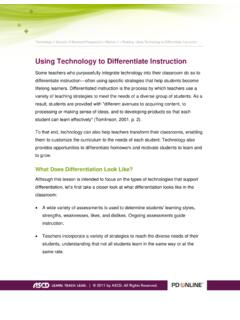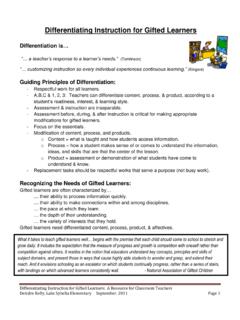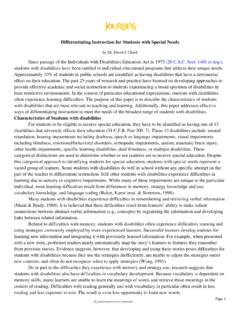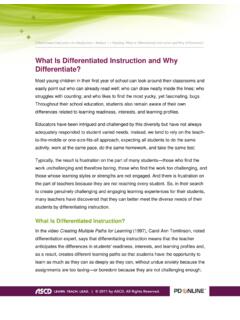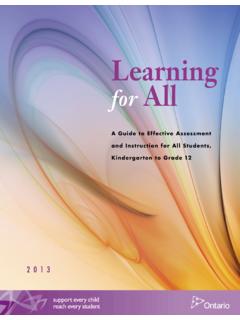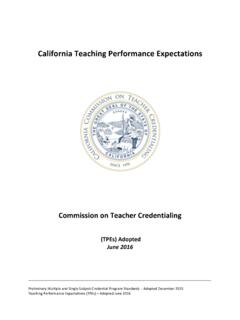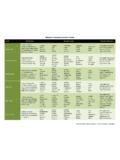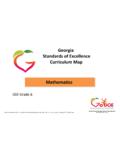Transcription of Differentiated Instructional Strategies to Accommodate ...
1 1 Differentiated Instructional Strategies to Accommodate Students with Varying Needs and Learning Styles Presentation for The Urban Education Conference Jackson State University Jackson, Mississippi November 18-20, 2013 By Ruben Gentry, Professor of Special Education Jackson State University (601) 979-1064 April P. Sallie, Graduate Student Jackson State University Carrie A. Sanders, Graduate Student Jackson State University 2 Differentiated Instructional Strategies to Accommodate Students with Varying Needs and Learning Styles Abstract: Students enter classrooms with different abilities, learning styles, and personalities. Educators are mandated to see that all students meet the standards of their district and state. Through the use of Differentiated Instructional Strategies , teachers can meet the varying needs of all students and help them to meet and exceed the established standards (Levy, 2008). Differentiated teaching provides paths to learning so that the classroom becomes a good fit for varied learners (Adami, 2004).
2 In this manuscript, the authors give the theory behind Differentiated instruction to enhance learning and provide practical examples of how to differentiate content, process, and product for students. Keywords: Differentiated instruction, learning styles, standards Introduction Educators are mandated to see that all students meet the standards of their district and state. Through the use of Differentiated Instructional Strategies , educators can meet the needs of all students and help them to meet and exceed the established standards (Levy, 2008). The objective is accomplished by choosing appropriate teaching methods to match each individual student s learning needs (Adami, 2004). Any group of students is likely to demonstrate considerable variation in their learning characteristics and behaviors. When the group includes students with learning deficiencies or other learning disorders, the amount of variation in learning is significantly increased. The diverse learning characteristics displayed by students in today s schools make it necessary for teachers to implement a wide variety of activities in their classes (Bender, 2012).
3 As classrooms 3 become more culturally diverse, it becomes more imperative to differentiate instruction (Cox, 2008). Differentiated instruction is appropriate for virtually all general education classes and is particularly beneficial to students with an array of learning challenges. Students demonstrate varying learning abilities, academic levels, learning styles, and learning preferences and need tailored instruction to meet their unique needs (Bender, 2012). Differentiated instruction recognizes the value and worth that exist in each individual; it allows students from all backgrounds and with diverse abilities to demonstrate what they know, understand, and are capable of doing (Adami, 2004). Differentiated instruction was originated by Tomlinson in 1999, basing it primarily on Howard Gardner s concept of multiple intelligences and brain-compatible research literature. Teachers were encouraged to consider students unique learning styles and differentiate educational activities to provide for their divergent learning styles by differentiating instruction in three areas: content, process, and product (Bender, 2012).
4 In differentiating instruction, teachers proactively modify the curriculum, teaching methods, resources, learning activities, and student products to address the needs of individual students and small groups of students to maximize the learning opportunity for each student in the classroom (Hillier, 2011). This study r eviews the literature on Differentiated instruction, surveys a select group of students interests and learning styles, and provides suggestions for meeting the educational needs of the students. Review of Related Literature Tomlinson and Allan (2000) defined differentiation as a teacher s reacting responsively to a learner s needs. The student s need may be to express humor, work with a group, have 4 additional teaching on a particular skill, delve more deeply into a particular topic, or have guided help with a reading passage and the teacher responds actively and positively to that need on an individual basis or with a small group of students. The authors further stated that the goal of Differentiated instruction is maximum student growth and individual success, and the key principles that guide Differentiated instruction include flexibility in learning goals, effective and ongoing assessment, flexible grouping, respectful activities and learning arrangements, and collaboration between students and teacher.
5 The elements of the curriculum that can be Differentiated are content (the facts, concepts, generalizations or principles, attitudes, and skills related to the subject), process (how the learner comes to make sense of, understand, and own the key facts, concepts, generalizations, and skills of the subject), and products (items a student can use to demonstrate what he or she has come to know, understand, and be able to do as the result of an extended period of study). Student characteristics for which teachers can differentiate are readiness, interest, and learning profile. Instructional Strategies that facilitate differentiation include learning centers, interest groups, group investigation, complex instruction, compacting, learning contracts, tiered activities, and tiered products. Every teacher differentiates instruction in one way or another, for example, by giving a student more time to finish an assignment, allowing children choice in what to read, or giving different types of assessments.
6 However, a teacher can make the classroom more responsive to student needs with a systematic approach to differentiation (Levy, 2008). Differentiated instruction means that teachers create different levels of expectations for task completion, and emphasize the creation of environments where all learners can be successful; it addresses the "how to" question for teachers and calls upon educators to be responsive to learners (Tobin, 2008). Hillier (2011) specifies four major principles of Differentiated instruction: it focuses on 5 the essentials (manipulate the complexity of activities and expectations), links assessment and instruction, involves collaborative learning between the teacher and students, and all students participating in respectful work. It is teaching with student variance in mind to maximize the capacity of each learner by bridging gaps in understanding and skills and helping each learner grow as much and as quickly as he or she can (Cox, 2008). Differentiated instruction integrates knowledge about constructivist learning theory, learning styles, and brain development with empirical research on influencing factors of learner readiness, interest, and intelligence preferences toward students motivation, engagement, and academic growth within schools (Tomlinson & Allan, 2000).
7 Teachers who differentiate instruction incorporate best practices in moving all of their students toward proficiency in the knowledge and skills established in state and local standards (Anderson, 2007). Differentiated instruction adapts learning to students unique differences (Chapman & King, 2005) based on students current abilities and understandings, personal interests, and learning preferences (Chamberlin & Powers, 2010). Effective characteristics of Differentiated instruction include clear learning goals, ongoing and diagnostic assessments that modify instruction and challenging tasks for all students (Chamberlin & Powers, 2010). Modifying instruction to draw on student interests is likely to result in greater student engagement, higher levels of intrinsic motivation, higher student productivity, greater student autonomy, increased achievement, and an improved sense of self-competence (Cox, 2008). The balance of this literature review focuses on the theoretical basis of Differentiated instruction, the three areas of differentiation, significance of learning and teaching styles, and some promising Strategies for meeting the needs of students with varying educational and learning needs.
8 6 Theoretical basis for Differentiated instruction Differentiated instruction was primarily based on the theory of multiple intelligences by Howard Gardner and brain-compatible research. Gardner postulated eight different intelligences that are relatively independent but interacting cognitive capacities. The intelligences are verbal-linguistic, logical-mathematical, musical, spatial, bodily-kinesthetic, naturalistic, interpersonal, intrapersonal, and a tentative ninth one, moral intelligence. Some students demonstrate strong intelligence in one area, whereas other may demonstrate strengths in several intelligences (Bender, 2012). Each child will have his or her own unique set of intellectual strengths and weaknesses (Brualdi, 1998). For clarity, learning style, learning preference, and multiple intelligences are often used synonymously (Bender, 2012; Brualdi, 1998). It is important, from a multiple intelligences perspective, that teachers take individual differences among students very seriously.
9 They should gear how to teach and how to evaluate to the needs of the particular child. The bottom line is having a deep interest in children and how their minds are different from one another to help them use their minds well. Linking the multiple intelligences with a curriculum focused on understanding is an extremely powerful intellectual undertaking (Brualdi, 1998; Checkley, 1997). Brain-compatible instruction is related to the multiple intelligences concept but it is more solidly grounded in the neurosciences. Brain-scanning techniques allow scientists to study performance of the human brain while the subject concentrates on different types of learning tasks. It has been discovered that brains perform best when highly motivated and involved and experiencing manageable stress (Bender, 2012). Three areas of Differentiated instruction 7 The core of Differentiated instruction is flexibility in content, process, and product based on students strengths, needs, and learning styles.
10 Content is what students are to master or learn from the instruction; process is how the students must complete the learning content; and product is how the learning is demonstrated or observed (Bender, 2012; Cox, 2008). In the content area each child is taught the same curriculum but it may be quantitatively or qualitatively different (Adami, 2004; Levy, 2008). Process includes how teachers teach and how students learn. The activities provided for student learning must address differing student abilities, learning styles, and interests. Teachers must adjust their teaching style to reflect the needs of different students by finding out where students are when they come into the process and building on their prior knowledge to advance their learning (Adami, 2004; Levy, 2008). Product is the way students demonstrate what they have learned. It must reflect student learning styles and abilities (Levy, 2008). Differentiation by product, or response, must also acknowledge, respect, and value the various ways that students may respond to an activity; but unfortunately, written work is still the predominate mode used by teachers for receiving feedback (Adami, 2004).










